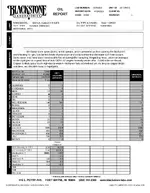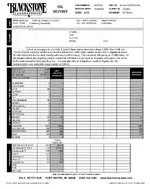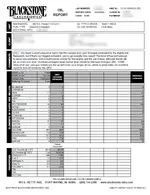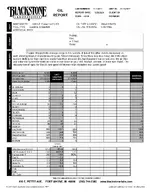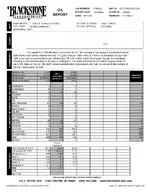This is the explanation of the report metrics from Blackstone.
Engine Report Explanation
Averages: Both the universal and unit averages are running averages and change with the number of samples we analyze.
Elements: Elements are quantified in the oil at parts per million levels (PPM). This list shows the most common sources of the elements in gasoline or diesel engine oil. Following each element is a description of where it comes from. They are grouped by category.
Wear Metals
Aluminum: Pistons, bearings. Clutch assembly and transmission components in motorcycles
Chromium: Rings, a trace element in steel
Iron: Cylinders, rotating shafts, the valve train, and any steel part sharing the oil. Transmission shafts/gears and bearings in motorcycles
Copper: Brass or bronze parts, copper bushings, bearings, oil coolers
Lead: Bearings, leaded gas, fuel additives
Tin: Bearings, bronze parts, piston coating (rare)
Nickel: Trace element in steel, platings on some cylinder types
Silver: Bearings
Titanium: Some intake valves and connecting rods, aftermarket parts, oil additive
Contaminants
Potassium: Antifreeze, additive in some oil types
Sodium: Antifreeze (ethylene glycol), additive in some gasoline engine oils. Sea water in marine engines
Silicon: Airborne dirt escaping air filtration, sealers, gaskets, sand-casted parts, and spray lubricants, antifreeze inhibitor, oil additives
Additives
Molybdenum: Anti-wear additive, some types of rings
Manganese: Trace element, additive in some gasoline
Boron: Anti-wear/anti-rust additive, antifreeze inhibitor
Calcium: Detergent/dispersant additive
Magnesium:
Detergent/dispersant additive
Phosphorus: Anti-wear additive
Zinc: Anti-wear additive
Barium: Detergent/dispersant additive used in some synthetics
Physical properties Viscosity/Flashpoint: If fuel is present in the oil, the Viscosity and Flashpoint will often be lower than stated in the “Values Should Be” line. A high viscosity may show oil oxidation or high levels of soot. It can also show an oil additive in use.
Fuel %: Indicates the amount of volatile fuel dilution found in the oil.
Antifreeze %: Indicates the amount of antifreeze found in the oil. A question mark means we found possible traces of coolant, but not enough to definitively say it’s there.
Water %: Indicates the amount of water found in the oil.
Insolubles %: Insolubles are solid materials present in the oil. They are typically free carbon from the oxidation of the oil itself, along with blow-by past the rings.
